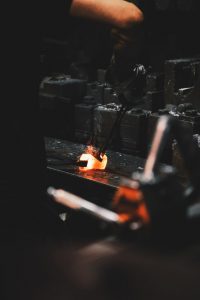Since 4000 BC, forging techniques have been practised in order to make tools and equipment used for day to day tasks. Now, over 6000 years later, we still use forging to create the tools and equipment we use in day to day life.
Find out more on what forging is and the different types of forgings available today.
Forging
What is forging?
Forging is a process in which heated metal is reshaped using force. After pre-heating the metal, it is pressed into a tool which then causes the metal to take the shape of the specific tool used.
Compared to forging in 4000 BC, where they used rocks to shape the metal, forging is much more advanced in the 21st century.
Types of Forging
Hand forging
Blacksmithing, which is more commonly known as hand forging, is a manual method of forging. Just like any forging process, the metal is heated in order to allow for the shaping process to begin. In hand forging the pre-heated metal is beaten into its desired shape using a hammer against a metal anvil.
Due to using a manual process of forging, hand forging provides a superior grain when compared to other forging methods due to the bending of the metal whilst its hot. Due to this bending, it means the forged item is much stronger and lasts longer compared to other forging methods.
Upset Forging
Heading, which also has the name of upset forging, is one of the more common forging techniques used in today’s day and age. The process involves a pre-heated bar which is position in between grooves whilst pressure is applied.
The dies applying pressure allow the hot metal to be shaped and in turn, the desired design can be achieved.


Drop Forging
Drop forging is a processed used in machine forging. This forgings process consists of a hammer which is dropped onto a heated piece of metal in order to shape it. Within drop forging there are two popular types of forging; Open die forging and Closed die forging.
Open die forgings are where the metal is placed on a stationary anvil and then shaped using the hammer. It gets its name ‘Open Die’ as the die does not fully enclose the metal when it is being forged.
Closed die forgings are different to open die in the respect that the dies are a fixed structured and therefore close around the metal when the pressure is being applied.